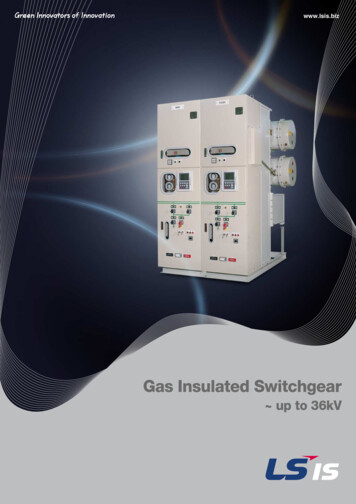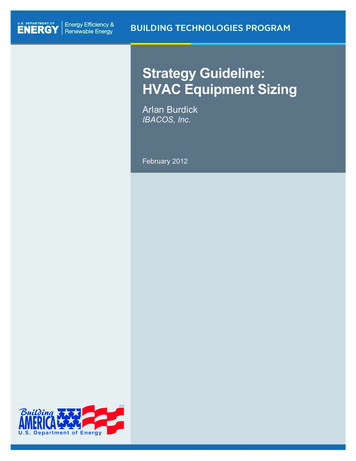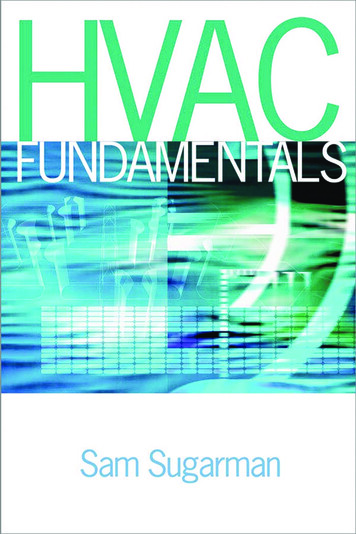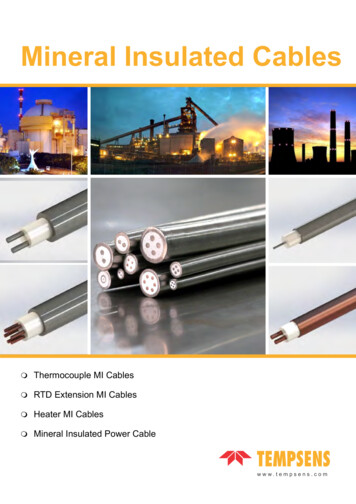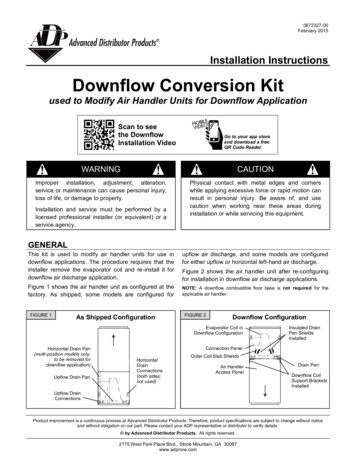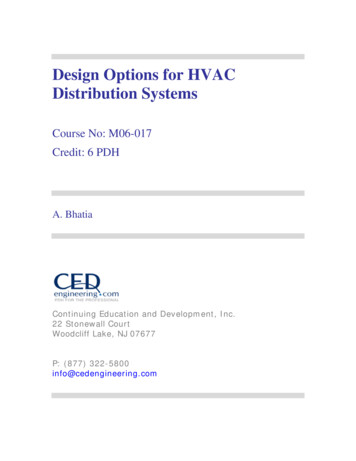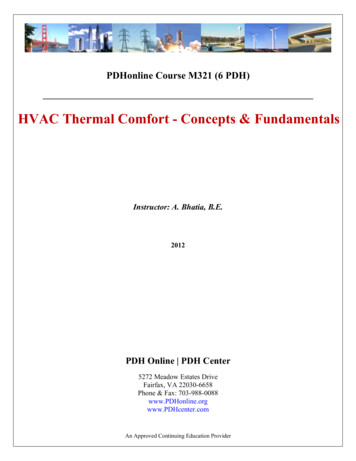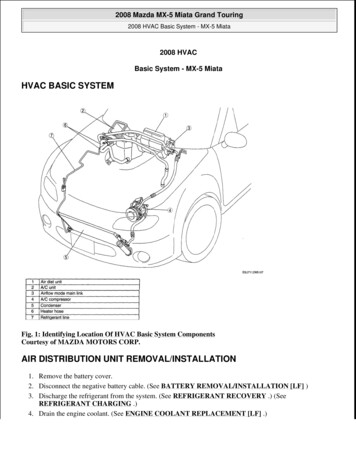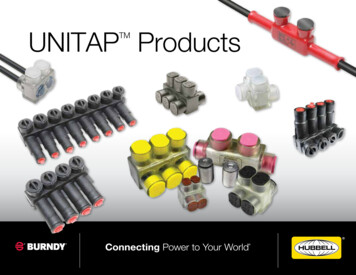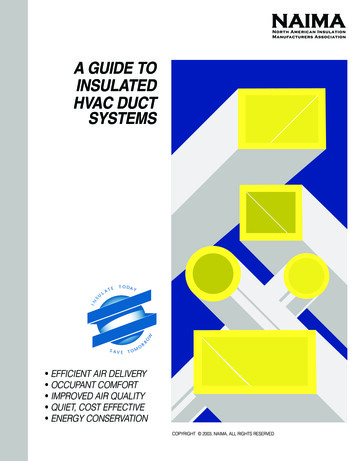
Transcription
A GUIDE TOINSULATEDHVAC DUCTSYSTEMS EFFICIENT AIR DELIVERY OCCUPANT COMFORT IMPROVED AIR QUALITY QUIET, COST EFFECTIVE ENERGY CONSERVATIONCOPYRIGHT 2003, NAIMA, ALL RIGHTS RESERVED
ContentsIntroduction .1General descriptions of types of insulated duct systems .2-5How fibrous glass duct insulation improves the indoor environment .6Codes and Standards .7-17Fibrous glass duct systems .18-21Sheet metal ducts with fibrous glass insulation liner .22-25Sheet metal ducts with fibrous glass insulation wrap.26-29Fibrous glass insulation boards.30-33Flexible duct systems.34-36Insulating return air systems, ducted and non-ducted .37Guide Specifications: 3-Part Masterformat Fibrous Glass Duct Work - Thermal/Acoustical Insulation .38-40Sheet Metal Ducts - Acoustical Lining Insulation .40-42Sheet Metal Ducts - Thermal Insulation Wrap .42,43Facts on fibrous glass duct insulation.44,45
FIBROUS GLASS INSULATED HVAC DUCT SYSTEMSFIBROUS GLASS INSULATED HVAC DUCT SYSTEMSand how they provide . Quiet, efficient air delivery Improved indoor environmental quality Cost-effective energy conservation Enhanced occupant comfortTypes of insulated air duct systemsThe five types of insulated air duct systems describedin this guide can be used to meet all widely usedarchitects’ or engineers’ specifications, local codes,owners’ comfort control requirements, installed andlife cycle cost criteria, or the contractor’s crew skilllevels and shop fabrication resources.IntroductionFibrous glass has been used as thermal and acousticalinsulation in forced air heating, ventilating, and airconditioning systems ever since these systems becamewidely available following World War II. Today, fibrousglass duct systems, duct liners, duct wraps, andcommercial insulation boards contribute to indoorenvironmental quality (IEQ) and occupant comfort inresidential, commercial, industrial, and public buildings ofall kinds. These include homes, apartments, schools,hotels, motels, medical facilities, theaters, shoppingcenters, office and government buildings, factories, andmany other types of structures where occupant comfortand indoor environmental quality are important criteria.Combining types of fibrous glass insulation in ductsystemsOften more than one of type of fibrous glass insulationtreatment may be specified in a single HVAC ductsystem. For example, in a variable air volume system,sheet metal ducts with fibrous glass duct liner may beused on the high pressure side if design static pressureexceeds the 2 in. w.g. (500 Pa) limits of the fibrous glassduct system; the fibrous glass duct system may be usedon the low pressure side; and insulated flexible ductsmay be used as run-outs from trunk ducts to diffusers.Fibrous glass insulation is used in air duct systems for fourbasic reasons: Temperature control - Delivery of heated or cooled air atcomfort levels suited to building occupancy requirements. Acoustical control - Absorption of noise generated bycentral air handling equipment and movement of airthrough the ducts, as well as “cross-talk” carried by ductsfrom one space to another. Condensation control – Prevents condensation in or onducts when installed R-value recommendations arefollowed, reducing the likelihood of moisture damage toceilings and other interior finishes.Energy conservation - Reduction of HVAC systemoperating costs by controlling heat loss or gain through airduct walls, helping systems run more efficiently. HVAC systems typically operate with internal airtemperatures between 40 F (4 C) and 250 F (121 C).Systems operating outside this range are not consideredin this guide, except that fibrous glass insulation boardsmay be used in systems operating at internal airtemperatures between 0 F (-18 C) and 450 F (232 C).1
FIBROUS GLASS INSULATED HVAC DUCT SYSTEMSGENERAL DESCRIPTIONSFibrous glass duct systemThe fibrous glass duct system is used to conserve heatingand cooling energy and to control duct-borne noise incommercial, institutional, or residential heating, ventilating,and air-conditioning ductwork operating in the range of 2in. w.g. ( 500 Pa) static pressure, up to at least 5,000 fpm(25.4 m/sec) internal air velocity, and internal airtemperature between 40 F (4 C) and 250 F (121 C). Ductsare only for indoor use and should be located in areaswhere ambient temperature does not exceed 150 F (66 C).The fibrous glass duct system is normally made up ofnominal four foot (1.2m) modules fabricated from 1, 11/2,or 2 in. (25, 38, or 51mm) thick, flat fibrous glass ductboard stock having a factory-applied reinforced aluminumexterior air barrier finish. Duct system modules arefabricated using either specially designed hand tools orgrooving and closure machines. Duct fittings such as tees,offsets, elbows, and transitions are also fabricated fromthese modules or from flat duct board stock.Duct board products are available with coated or facedairstream surfaces. These products permit rigorouscleaning of the duct surface where dust has been allowedto collect in the duct due to lack of filtration or poormaintenance. Additionally, some of these products havehigher maximum velocity ratings.Duct systems fabricated from fibrous glass duct boardproducts qualify under UL 181 as Class 1 Air Ducts,meeting the fire safety requirements of NFPA 90A and 90Bincluding limited combustibility. They also comply with allwidely used model codes. Duct board joint closures aresealed using one of three UL 181A listed systems.UL 181A closuresystems providesubstantially air-tightsealingReinforced aluminumfoil/kraft laminate,air barrier, and vapor retarderFactory-molded male and female shiplapjoints between sectionsThermally effective fibrous glass insulationInternal surface treatments enhance cleanabilityFig. 1. Fibrous glass duct module2
FIBROUS GLASS INSULATED HVAC DUCT SYSTEMSSheet metal ducts lined with fibrous glass insulationFibrous glass duct liners are manufactured to comply withASTM C 1071, Standard Specification for Fibrous GlassLining Insulation (Thermal and Sound Absorbing Material).These products are available with coated or facedairstream surfaces.Fibrous glass duct liner insulation is designed forapplication to the interiors of commercial and residentialsheet metal heating, ventilating, and air-conditioning ductsto attenuate noise generated by central air handlingequipment, air movement within the ducts, and occupantcross-talk. It also serves to reduce heat loss or gainthrough sheet metal duct surfaces, and helps to preventthe formation of water vapor condensation both inside theduct and on its exterior surface. Fibrous glass duct linerinsulation is fabricated along with the sheet metal work inthe shop, providing quality workmanship under controlledconditions.Fibrous glass duct liner insulations are manufacturedfrom glass fibers bonded with thermosetting resin. Theyare dimensionally stable, withstand abuse, and provide acleanable, fire-resistant interior surface designed tominimize friction loss. Two forms are available:(1) Flexible blankets, supplied in roll form;(2) Rigid boards, supplied in sheet form.Sheet metal ductsmust be tightly sealedAvailable in thicknesses from 1/2 to 2 in.(13 to 51mm)Tough airstream surface resists shop,installation, and service damageDuct liner secured to sheet metal withadhesives plus metal fastenersFig. 2. Sheet metal duct lined with fibrous glass insulation3
FIBROUS GLASS INSULATED HVAC DUCT SYSTEMSGENERAL DESCRIPTIONSSheet metal ducts with exterior fibrous glass exteriorinsulationInsulation BoardsFibrous glass insulation boards are also available forapplication to the outside of sealed sheet metal ducts,housings, and plenums. These are available unfaced,or with reinforced foil (FSK) or all-service jacket (ASJ)vapor retarder facings, in a range of densities andthicknesses. Some are flexible enough to conform tocurved surfaces such as large round or oval sheetmetal ducts.Fibrous glass insulation boards can be used inapplications operating within the temperature range of 0 F(-18 C) to 450 F (232 C).Fibrous glass insulation boards are manufactured tocomply with ASTM C 612, Standard Specification forMineral Fiber Block and Board Thermal Insulation.Flexible BlanketFibrous glass duct wrap insulation is designed forapplication to the exteriors of commercial and residentialsheet metal heating, ventilating, and air-conditioning ductsand plenums operating at temperatures between 40 F(4 C) and 250 F (121 C). Duct wrap insulation reducesheat loss or gain through duct walls, conserving energyand controlling moisture condensation. Fibrous glass ductwrap insulations are useful in situations where acousticalperformance is not an issue.Fibrous glass duct wrap insulations are flexible, resilient,light-density blankets of glass fibers factory-laminatedto vapor retarder facings. These products are easily cutand fitted to achieve a neat, thermally effective insulationblanket over the exteriors of rectangular, round, oval, orirregularly shaped ducts.Fibrous glass duct wrap insulations are manufactured tocomply with ASTM C 1290, Flexible Fibrous Glass BlanketInsulation USed to Externally Insulate HVAC Ducts.Sheet metal ducts must firstbe tightly sealedReinforcedfoil/kraft laminatevapor retarder facingResilient fibrous glass insulation,thicknesses from 11/2 to 4 in.(38 to 102mm)Correct installation proceduresassure installed R-values will be metFig. 3. Metal duct with exterior insulation wrap4
FIBROUS GLASS INSULATED HVAC DUCT SYSTEMSFibrous glass insulated flexible ductsFlexible ducts insulated with fibrous glass are an efficient,economical way to install connections between trunkducts and room diffusers or registers. A spiralwire-reinforced inner air conduit is wrapped with resilientfibrous glass and jacketed with a flexible vapor retarder ofreinforced foil or plastic film. These flexible products canconform to bends when connecting trunk ducts todiffusers, or when routing ductwork through obstructedareas. (NAIMA members do not manufacture flexibleducts, but do supply the flexible duct industry with fibrousglass insulation.)Fibrous glass insulated flexible ducts can be used inapplications where internal air temperatures do notexceed 250 F (121 C).Fibrous glass insulated flexible ducts systems aremanufactured to comply with Air Diffusion Council TestCode FD-72-R1. They also meet requirements of UL181,and comply with all widely used model building codes.Flexibility is an advantage wheninstalling in obstructed areasExterior plastic or laminatevapor retarder jacketLight density fibrous glass insulationInner air conduit with spiral reinforcing wireFig. 4. Insulated flexible duct5
FIBROUS GLASS INSULATED HVAC DUCT SYSTEMSHOW FIBROUS GLASS DUCT INSULATION IMPROVES THE INDOOR ENVIRONMENTTemperature control:Fibrous glass duct insulation means enhanced comfort. Ithelps to ensure that heated or cooled air will betransmitted from central air equipment to working andliving spaces at comfort levels suited to occupants’ needs.Increased occupant comfort in commercial buildingscontributes to increased productivity; in residentialbuildings, to an enhanced sense of well-being. In eithercase, fibrous glass duct insulation allows the buildingowner to utilize central equipment effectively—or, in manyinstances, to provide desired comfort levels with centralequipment of less capacity and cost than would berequired when ducts are not thermally insulated.building materials. Adding insulation is the best way tocontrol surface condensation.Mold and fungus resistance:Fibrous glass duct insulation will not support the growthof mold when tested in accordance with applicable ASTMand UL specifications. Furthermore, fibrous glass ductinsulation products designed for installation inside air ductsare tested for mold and bacteria resistance in accordancewith ASTM test procedures. Fibrous glass insulationinstalled in clean, dry, well-maintained air duct systems willnot contribute to mold, fungal, or bacterial amplificationand consequent contamination of the indoor environment.Acoustical control:Fibrous glass duct insulation means peace and quiet.It is a key contributor to the creation of an acousticallysatisfying indoor environment by absorbing noisegenerated by central air equipment, by expansion andcontraction of duct components, and from air movementnoise within the ducts. It also contributes to personalprivacy and productivity by preventing the ductwork fromtransmitting unwanted conversations from room to room inthe home or workplace. No other forms of duct insulation,including elastomeric foams and reflective products, canmatch the acoustical effectiveness of fibrous glassinsulation applied to control noise in air handling systems.Fire safety:Fibrous glass duct insulation means fire safety. ASTM,UL, and NFPA fire safety test methods all show fibrousglass to resist flame spread from external or internal firesources. Fibrous glass duct insulations are tested towithstand flame penetration. They resist ignition by small,low-energy flames and will not spread fire from suchsources.Durability and integrity:Fibrous glass duct insulation means durability. Theirconsistent resin-bonded fiber structures and tough, abuseresistant, mat-faced or coated airstream surfaces providelong-term thermal, acoustical, and condensation controlperformance without deterioration and with no measurablefiber erosion. They resist damage both during installationand in service. Fibrous glass insulation products installedwithin the ducts may be readily cleaned in situations wheredust has been allowed to enter the duct system due toabsence of filtration or poor maintenance.Energy conservation:Fibrous glass duct insulation means energy saved. Thesame thermal performance properties that contribute tooccupant comfort also enable fibrous glass duct insulationto control heat loss or gain through duct walls withefficiency not equaled by other forms of duct insulation.By enabling ducts to transmit heated or cooled air tooccupied spaces at design temperatures, buildingoperating cost is reduced—sparing the environment fromadditional greenhouse gases released into the air.Proven performance:Fibrous glass duct insulation means proven performance.These products are manufactured to meet exactingphysical property and performance requirements set forthin ASTM, UL, and NFPA standards and test procedures.The design, fabrication, and installation of air ductsystems insulated with fibrous glass are all accomplishedby skilled, trained contractors supported bycomprehensive industry standards, including NAIMA’s“Work Smart” program which covers recommendedpractices for the handling and installation of all kinds offibrous glass insulation products.Condensation control:Fibrous glass duct insulation means dry ductwork. Whenwarm, humid air comes in contact with the surfaces ofuninsulated cold air ductwork, water vapor will condenseand result in dripping of liquid water from duct surfacesonto other building components. Installing insulation withsufficient R-value along with a low permeance vaporretarder will minimize, and in most cases prevent,condensation problems and consequent damage to6
FIBROUS GLASS INSULATED HVAC DUCT SYSTEMSCODES AND STANDARDSAny building project, whether new construction or retrofit,is first subject to state laws and/or local ordinances. Theselaws and ordinances in turn reference codes governing anumber of issues that affect the design and constructionof HVAC duct systems, among them building safety,indoor environmental quality and energy conservation.These building codes, in turn, reference standards that setforth how building materials and systems shall bemanufactured, fabricated, installed, and tested to ensurecompliance with code requirements. Incorporated intostate laws and local ordinances, these codes andstandards thus have the force of law.Among the codes developed by ICC, the following most directlyrelate to HVAC duct systems in commercial construction: International Mechanical Code International Energy Conservation CodeThese codes supersede: BOCA National Code, 1996 Edition and NationalMechanical Code, 1996 Edition ICBO Uniform Building Code, 1997 Edition andUniform Mechanical Code, 1997 Edition SBCCI Standard Building Code, 1997 Edition andStandard Mechanical Code, 1997 Edition CABO (Council of American Building Officials)Model Energy Code, 1997 Edition1. INTERNATIONAL CODE COUNCIL (ICC)From early in the last century there existed three majorcode authorities, each of which had established and wasmaintaining its own set of model building codes indifferent parts of the United States. These threeauthorities were:ICC codes relating to HVAC duct systems in residential orlight commercial construction include: International Residential Code International Energy Conservation CodeThese codes supersede: CABO One and Two Family Dwelling Code, 1995 Edition Building Officials and Code AdministratorsInternational (BOCA) International Conference of Building Officials (ICBO) Southern Building Code Congress International (SBCCI)Although these codes also deal with issues such as firesafety, indoor environmental quality, and acoustics (amongothers), the key concerns relative to HVAC duct systeminsulation can be summed up as follows:In 1994, recognizing the need for a single set of codeswithout regional limitations, these three groups establishedThe International Code Council (ICC). Its mission: “Topromulgate a comprehensive and compatible regulatorysystem for the built environment, through consistentperformance-based regulations that are effective, efficientand meet government, industry and public needs.”Mechanical codes answer the question, “What physicalproperties are required of the insulation?”Energy codes answer the question, “How muchinsulation is needed in this particular application?”While the ordinances of some local jurisdictions may stillreference BOCA, ICBO, and SBCCI codes, nation-wideacceptance of the ICC set of codes is fast becoming areality, This makes it possible for architects, engineers,manufacturers of building materials and systems,contractors, and code enforcement officials to work withthe same regulatory system anywhere in the United States.2. MECHANICAL, ENVIRONMENTAL, AND OTHERSTANDARDSICC codes incorporate by reference the mechanical, firesafety, indoor environmental quality, and other standardspromulgated by the following organizations: National Fire Protection Association (NFPA) Underwriters Laboratories, Inc. (UL) and its Canadianaffiliate (ULC) American Society for Testing and Materials (ASTM)It should be noted that some states have established theirown building, energy or environmental codes,and that these codes do not necessarily relate to the ICCset of codes. Some state codes may be more or lessstringent than the ICC codes.Following is a summary of Standards promulgated bythe above authorities which are most important to thedesign, fabrication, and installation of HVAC ductsystems incorporating fibrous glass insulation.7
FIBROUS GLASS INSULATED HVAC DUCT SYSTEMSA. National Fire Protection Association (NFPA)of continued combustion and of such composition thatsurfaces that would be exposed by cutting through thematerial on any plane would have neither a flame spreadrating greater than 25 nor evidence of continuedprogressive combustion.”i. NFPA Standard 90A, Standard for the Installation ofAir Conditioning/Ventilating Systems, 2002 EditionThis Standard states that “Class 1 rigid or flexible air ductstested in accordance with UL 181 Standard for Safety,Factory-Made Air Ducts and Air Connectors, and installedin conformance with the conditions of listing, shall bepermitted to be used for ducts when the air temperature inthe duct does not exceed 121 C (250 F) or when used asvertical ducts up to two stories in height.”ii. NFPA Standard 90B, Standard for the Installation ofWarm Air Heating/Air Conditioning Systems, 1999EditionWith respect to fire safety of air duct systems, therequirements and definitions of this Standard areidentical to those of NFPA Standard 90A.This Standard also requires that supplementary materialsincluding duct coverings, duct linings, vapor retarderfacings, adhesives, fasteners, and tapes “shall have, inthe form in which they are used, a maximum flame spreadindex of 25 without evidence of continued progressivecombustion and a maximum smoke developed index of50 when tested in accordance with NFPA 255, StandardMethod of Test of Surface Burning Characteristics ofBuilding Materials.” The Standard further requires thatair duct, panel, and plenum coverings and linings “shallnot flame, glow, smolder, or smoke” when tested inaccordance with ASTM C 411, Standard Test Method forHot-Surface Performance of High Temperature ThermalInsulation, “at the temperature to which they are exposedin service.” In no case shall the test temperature be below121 C (250 F).These two companion standards serve as the basis formany other codes, standards and specifications. Theyencompass all of the fibrous glass duct insulation systemsdiscussed herein.iii. NFPA 255, Method of Test of Surface BurningCharacteristics of Building MaterialsThis Standard sets forth test methods for determiningthe surface burning characteristics of building materials,including those used in HVAC duct systems. ThisStandard is considered by most building code officials tobe equivalent to the following: ASTM E 84, Standard Test Method for Surface BurningCharacteristics of Building Materials UL 723, Tests for Surface Burning Characteristics ofBuilding Materials CAN/ULC-S102, Tests for Surface BurningCharacteristics of Building Materials (Canada)The Standard defines a limited combustible material asone “that does not comply with the definition of noncombustible material that, in the form in which it is used,has a potential heat value not exceeding 8141 kJ/kg (3500Btu/lb) (see NFPA 259, Standard Test Method for PotentialHeat of Building Materials), and that complies with eitherof the following (a) or (b). Materials subject to increase incombustibility or flame spread rating beyond the limitsherein established through the effects of age, moisture, orother atmospheric condition shall beconsidered combustible. (a) Materials having a structuralbase of noncombustible material, with a surfacing notexceeding a thickness of 3.2 mm (1/8 in.) and with a flamespread rating not greater than 50. (b) Materials in the formand thickness used, other than as described in (a), havingneither a flame spread rating greater than 25 nor evidenceiv. NFPA 259, Standard Test Method for Potential Heat ofBuilding MaterialsThis Standard, is referenced in NFPA 90A, sets forthmethods of establishing the limited combustibilityclassification of thermal insulating materials.8
FIBROUS GLASS INSULATED HVAC DUCT SYSTEMSB. Underwriters Laboratories Inc. (UL)i. UL 181, Standard for Safety, Factory-Made Air Ductsand Air Connectorsii. UL 181A, Standard for Closure Systems for Use withRigid Air Ducts (2nd Edition, 1994)This Standard specifies requirements for materials usedin the manufacture of factory-made air ducts and airconnector systems for use in accordance with NFPAStandards 90A and 90B and the ICC InternationalMechanical Code. Fibrous glass duct products andsystems are classified as Class 1, having a flame spreadindex not exceeding 25 without evidence of continuedprogressive combustion and a smoke developed indexnot exceeding 50. This Standard also establishes a testprogram applicable to both rigid and flexible fibrous glassduct products and systems as shown in the table below.This standard specifies materials and techniques used inmaking the following listed closures in rigid duct systems:Surface burning characteristicsFlame PenetrationBurningCorrosion (a)Mold Growth and HumidityTemperaturePunctureStatic dingLeakageRIGID Pressure-sensitive aluminum foil tape UL 181A, Part I (P) Heat-activated aluminum foil tapeUL 181A, Part II (H) Glass fiber fabric and masticUL 181A, Part III (M)Under the UL 181A listing procedures an individualclosure system may be qualified for use on allmanufacturers’ fibrous glass duct materials which meetthe UL 181 requirement. Use of any non-listed closuresystem voids the UL 181 Class 1 Air Duct Rating.FLEXIBLE (b) iii. UL 181B, Standard for Closure Systems for Use withFlexible Air Ducts and Connectors (1st Edition, 1995)This standard specifies materials and techniques usedin making closures in flexible duct systems by means ofplastic or metal closure straps, tapes, and mastics. Underthe UL 181B listing procedures an individual closuresystem may be qualified for use on all manufacturers’flexible duct products which meet the UL 181 requirement.Use of any non-listed closure system voids the UL 181Class 1 Air Duct Rating.iv. UL 723, Tests for Surface Burning Characteristics ofBuilding MaterialsAs noted, this Standard is considered by most buildingcode officials to be equivalent to the surface burningcharacteristics tests set forth in ASTM E 84, NFPA 255,and CAN/ULC-S102.(a) Applicable to parts of metals not inherently corrosion resistant.(b) Test applicable for flexible air ducts and air connectors thatincorporate vapor retarders supported by grommets or other meansof field support.C. American Society For Testing and Materials (ASTM)i. ASTM E 84, Standard Test Method for Surface BurningCharacteristics of Building MaterialsAs noted, this Standard is considered by most buildingcode officials to be equivalent to the surface burningcharacteristics tests set forth in UL 723, NFPA 255, andCAN/ULC-S102.9
FIBROUS GLASS INSULATED HVAC DUCT SYSTEMSii. ASTM C 411, Test Method for Hot-Surface Performanceof High-Temperature Thermal Insulation ASTM G 21-96, Practice for Determining Resistance ofSynthetic Polymer Materials to Fungi ASTM G 22-96, Practice for Determining Resistance ofPlastics to Bacteria ASTM C 916, Standard Specification for Adhesives forDuct Liner InsulationThis Test Method covers determination of the performanceof block and pipe forms of thermal insulating materialswhen exposed to simulated hot-surface applicationconditions. The term “hot-surface performance” refers to asimulated use-temperature test in which the heatedtesting surface is in a horizontal position. This testmethod refers primarily to high-temperature insulationsapplicable to hot-side temperatures in excess of 200 F(93 C). It may be used for materials such as preformedinsulation, blanket insulations, and insulating cements.vii. ASTM C 1290, Flexible Fibrous Glass BlanketInsulation Used to Externally Insulate HVAC DuctsThis Specification covers the composition, physicalproperties, and dimensions of fibrous glass duct wrapinsulation as described on pages 26-29 of this Guide.iii. ASTM C 423, Test Method for Sound Absorption andSound Absorption Coefficients by the ReverberationRoom MethodD. Manufacturing, Fabrication, and InstallationStandardsStandards governing the design, fabrication, andinstallation of HVAC duct systems include those of thefollowing organizations:This Standard establishes methods of determining soundabsorption properties of fibrous glass duct board and ductliner. North American Insulation Manufacturers Association(NAIMA). Members of this association include the fourmanufacturers of fibrous glass air duct insulation products. Sheet Metal & Air Conditioning Contractors NationalAssociation (SMACNA). As the name implies, thisassociation includes companies that fabricate andinstall air duct systems incorporating fibrous glassinsulation products. Air Diffusion Council (ADC). This organization includesmanufacturers of various classes of flexible ductmaterials including those which incorporate fibrousglass insulation. Midwest Insulation Contractors Association (MICA).This organization is chiefly concerned with mechanicaland industrial insulation, but air duct and plenuminsulation is included.iv. ASTM C 518, Test Method for Steady-State Heat FluxMeasurement and Thermal Transmission Properties byMeans of the Heat Flow Meter ApparatusThis Standard establishes methods of determiningthermal performance properties of fibrous glass ductboard, duct liner, duct wrap, and insulation boards
HVAC systems typically operate with internal air temperatures between 40 F (4 C) and 250 F (121 C). Systems operating outside this range are not considered in this guide, except that fibrous glass insulation boards may be used in systems operating at internal
